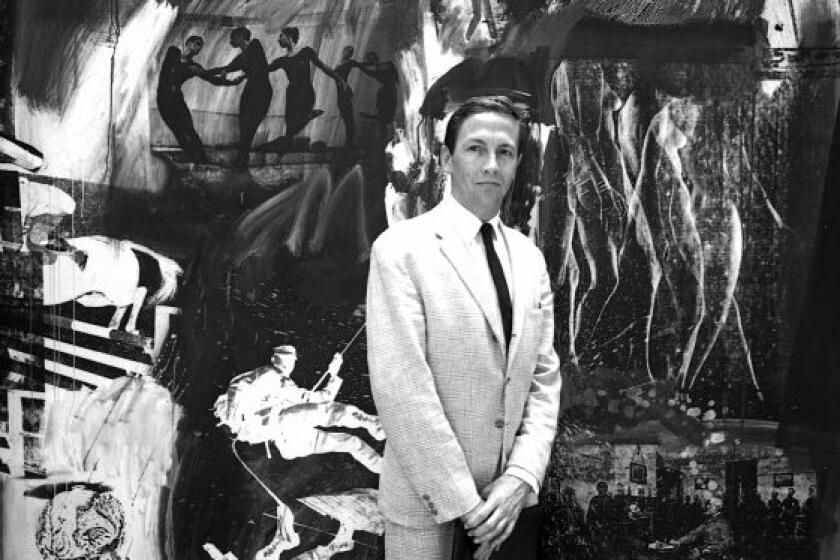Perfoming Arts : Klezmer on the Cutting Edge : How did such low-rent Jewish party music turn into an avant-garde trend? We’d tell you, but we can’t stop dancing.
One of the hippest records to have come out this year is a CD resurrection of goofy early Spike Jones recordings. Spike Jones was the drummer from Long Beach who played in radio bands in the 1930s and then, in the early ‘40s, set out on his own as a musical satirist, famous for making lots of nerdy noises to parody popular songs, with his band, Spike Jones & the City Slickers. By the ‘50s, when he went on television, his act had become tired and its spirit a little mean; his old LPs, for most of his old fans, have wound up in attic with the tattered Mad magazines and other nutty juvenalia.
What makes “Spiked! The Music of Spike Jones” hip is that it is released on Catalyst, a trendy and sophisticated new-music label; it contains liner notes by the reclusive cult novelist Thomas Pynchon, and it flaunts flashy cover art by cartoonist Art Spiegelman, of “Maus” fame.
Some extravagant claims are made for this record. Its executive producer, Tim Page, who is also chief classical music critic at Newsday, adds to the liner notes that all Jones’ cowbells, gunshots, car horns and crashes helped pave the way for everything from John Cage to Public Enemy. Jones was not nearly that prescient, of course; American experimental music was honking car horns and smashing beer bottles years before Jones came on the scene.
But Spike Jones did reveal at least one particularly quirky and genuine sign of prescience buried in some of the cuts. For a couple of years in the mid-’40s, Jones’ clarinetist--and what Pynchon calls “Slicker glug specialist”--was Mickey Katz. Katz went on, in the ‘50s, to create his own comedy routines of Yiddish musical parody. In the process, Katz bowdlerized an old Yiddish folk music style, klezmer, sometimes called Jewish jazz, the celebratory secular music of weddings and bar mitzvahs.
Katz’s LPs went out of fashion with the ‘50s, and Katz ultimately became better known as the father of the entertainer Joel Grey than of any musical trend. But then, last year, Nonesuch put out a recording called “Don Byron Plays the Music of Mickey Katz,” resulting in a startling cultural confusion. Don Byron is a Boston-based young black clarinetist who is also a regular in Manhattan’s downtown avant-garde jazz scene. In addition, he heads an Afro-Cuban jazz band as well as a modern classical ensemble, and he is currently writing a string quartet for the Kronos Quartet. He is not Jewish.
Nor is Byron the only member of the hip art world lately drawn to klezmer. Anyone looking for a particularly off-the-wall Hanukkah party record might try the klezmer-tinged title track from “Transylvania Softwear,” (John Marks Records), the latest effort from the avant-garde accordionist, Guy Klucevsek, who has practically single-handedly made his instrument newly fashionable in the downtown new-music dance clubs. But then even John Zorn, saxophonist and avatar of downtown postmodern improvisers, has begun playing his versions of klezmer.
Klezmer has, in fact, invaded the avant-garde in a number of unlikely ways. The postmodern choreographer David Gordon directed the klezmer musical “Shlemiel the First” last year for American Repertory Theater in Cambridge, Mass., which became a New York hit last summer when it visited Lincoln Center’s showcase of avant-garde performance, “Serious Fun!” And now Richard Forman, the avant-garde director, is currently preparing a new work of music theater, “Yiddisher Teddy Bears,” for his Ontological-Hysteric Theater, with music by Stewart Wallace, also composer of the forthcoming opera “Harvey Milk.”
Why klezmer? And why now?
There are all kinds of issues that can be raised here, issues of postmodernism and multiculturalism. There are all the usual social and ethnic questions to be asked. But there is something else. It is what the Polish klezmer musician, Leopold Kozlowski, says while chopping garlic in a new documentary, “The Last Klezmer” (which plays weekends at the Sunset 5). Of the garlic, Kozlowski says simply, “It’s a pleasure.”
Klezmer is back, most likely, for the same simple reason. It’s a pleasure, and it’s all the more one because it is a pleasure that had been forgotten.
Klezmer is the ultimate low-rent party music. Its roots are murky, but it comes from the entertainment music that developed in Eastern Europe sometime in the latter part of the last century. There seems to have been little room in Jewish culture for secular music before that. Unlike the fabulous body of sacred music that arose out of Christianity, Jewish music of worship remained unadorned chant. Klezmer, which means in Yiddish vessel of music , was the entertainment at weddings and bar mitzvahs.
Originally klezmer was the musical equivalent of Yiddish, a folk-based music that adapted to whatever musical language was around it. But with the rise of Yiddish theater in the late 1800s, it traveled to the United States along with the huge wave of Jewish emigrants from Eastern Europe.
In America, klezmer adapted. It took on many of the trappings of jazz. Klezmer big bands were formed in the ‘20s, and many klezmer musicians also got jobs in regular jazz bands as well. Indeed, like much else in Jewish life, klezmer became an assimilated art.
By World War II, with American Jews becoming increasingly assimilated into middle-class culture and society, the klezmer bands died out almost entirely, surviving only to play weddings and bar mitzvahs. But that also made klezmer a particularly apt vehicle for Mickey Katz’s parodies of the middle-class assimilation. So where Spike Jones would spoof Stephen Foster with “I Dream of Brownie in the Light Blue Jeans,” Katz came up with “Haim Afen Range” (“Home on the Range”) and “Paisach in Portugal” (“April in Portugal”), both hilariously included in Don Byron’s recording.
Like all else in ethnic culture, klezmer also eventually entered the academy, most notably at the New England Conservatory of Music, where Hankus Netsky, chairman of the jazz studies department, founded the Klezmer Conservatory Band. Coming out of that department and that band, Byron became the most prominent musician of new generation that viewed klezmer perhaps in a more true spirit than many who attempt to preserve it as tradition. Recognizing that klezmer was a musical expression of Jewish secular life, not of Judaism, and that klezmer never was any one definable sort of tradition, Byron, in a true postmodern fashion, removed the tradition from its usual context so as to appreciate things in it that might have been overlooked.
Byron does this mainly through shock--the shock of a jazz cat with dreadlocks. Byron plays exact transcriptions of Katz recordings. He even employs a singer who mimics Katz’s accents and Yiddish humor.
But he also creates a new, late 20th-Century context in which to hear Katz anew. He begins his recording by musically identifying both himself and Katz, dubbing old Katz recordings on top of Byron’s own hallucinatory jazz style. That sets the scene for the more subtle shock effect of hearing Katz’s music played with exquisite virtuosity in clear, clean sound, re-created with a kind of loving care for the music itself.
Byron’s is ultimately a surreal vision. He may, like Page, get carried away when, in the notes, he compares Katz to the unlikely likes of Art Blakey and Harry Partch--Katz was no more a precursor of progressive jazz or experimental American music than his mentor, Spike Jones, was of rap or the avant-garde--but the music does have a way changing perceptions.
But just as curious as Byron’s cultural confusion is the fact that klezmer has also now reached the concert stage, where it never has been welcomed. Its poor reputation has traditionally made even important Jewish composers wary of it. Copland could happily turn to jazz or mariachi music; Leonard Bernstein could adapt just about any popular music; Marc Blitzstein was happy with the seediest styles--but none touched klezmer.
Just ask the American Paul Schoenfeld, whose flute concerto, “Klezmer Rondos,” recently recorded on Argo, is attracting a great deal of attention just about everywhere except Israel, where he lives on a kibbutz and where klezmer remains, at least in high culture circles, declasse.
Schoenfeld, himself, says that his attraction to klezmer had little to do with his ethnic background. A converted modernist, the first time he heard klezmer he had the same reaction that he had when he heard Scott Joplin piano rags for the first time. He liked it. And he likes to use music he likes in his music, whether that music happens to be swing or country fiddle music or klezmer.
But, now, there is no predicting where klezmer will turn up next. Later this season, the Chamber Music Society of Lincoln Center will perform a new chamber piece, “Seven Prayers of Isaac the Blind,” for clarinet and string quartet, by the Argentine composer of Russian Jewish parents, Osvaldo Golijov. Golijov, a composer much in demand these days and a particular favorite of the Kronos Quartet, lives in Boston and writes in a style that has much in common with the intense spiritual minimalism very in vogue in Eastern Europe and the Russian republics. But his new quintet happens to be written for the klezmer clarinetist Goira Feidman.
There is but one parallel in recent years to this klezmer craze. Despite the growing interest in world music, the tango is the only other ethnic musical style that has a widespread assimilation into pop and classical, dance, music theater, performance art, opera, as well as uptown and downtown venues, all at the same time. And if it keeps up like this, klezmer could well become the next tango.
More to Read
The biggest entertainment stories
Get our big stories about Hollywood, film, television, music, arts, culture and more right in your inbox as soon as they publish.
You may occasionally receive promotional content from the Los Angeles Times.







